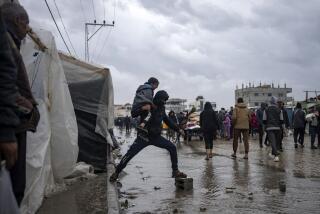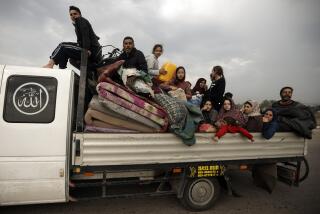Iraqi Shiite Resistance Still Battling : Refugees: The Iranian border city of Khorramshahr now serves as a hub of exile activity in fight against Hussein.
- Share via
KHORRAMSHAHR, Iran — Almost every night, Iraqi refugees near this shattered port city on the southern frontier of Iraq report the sound of gunfire between the border and Basra, Iraq’s second-largest city.
“The Iraqi resistance fighters are attacking Saddam Hussein’s troops,” said Abu Taisier, a 29-year-old Iraqi mullah who comes from the Shiite Muslim holy city of Najaf. “Our men are active and have forced the Iraqis to shut down the main road between Basra and Amarah to the north at 5 o’clock in the afternoon.”
Taisier sat on a Persian carpet in his cheerless, borrowed office in a government ministry here to coordinate activities of Iraqi Shiite refugees.
Last Thursday, Taisier said, 300 resistance fighters attacked government troops between here and Basra, 30 miles up the strategic Shatt al Arab waterway, and killed about 40, losing four of their own killed and three wounded. They took seven prisoners, the mullah said.
There was no way to independently confirm his account of the skirmish, but Iraqi guerrillas operating out of Khorramshahr are clearly able to infiltrate the long, flat, border at will.
The unguarded frontier stretches from Khorramshahr to an Iraqi refugee camp at Shalamcheh, several miles west of here--a collection of green and khaki tents housing an estimated 4,000 refugees from Iraq.
The flow that brought about 55,000 Iraqi Shiite refugees here has dwindled to a trickle, local sources say, because Iraq closed the border on its side 25 days ago. Further, many refugees fear to cross the open fields that once produced rice because they were strewn with mines planted by both sides during the 1980-88 Iran-Iraq War.
While Iraqi Kurdish refugees suffer from cold in the mountains along the Turkish border, here the Shiite refugees swelter in the delta country in the Karun River. Temperatures already approach 90 degrees before noon, and the heat becomes unbearable in high summer.
The refugees staunchly support resistance groups, which generally call themselves moujahedeen (holy warriors) and which are organized into groups such as that of the young mullah, known as the Supreme Assembly of the Islamic Revolution in Iraq.
The Iranian government also supports the resistance groups because of its hostility to the regime of Iraq’s President Hussein.
Khorramshahr now serves as a hub of exile activity in support of the Shiite religious movement in southern Iraq against the Hussein’s Sunni Muslim regime.
As such, Khorramshahr is the symbol of the Iranian fighting spirit against Iraq. Its name has a resonance for Iranians similar to that of Stalingrad for Soviet citizens.
Stalingrad, a city divided by the Volga River, was where the Soviets held the east bank while German invaders pounded them from the west side of the city. Khorramshahr--the name means “green city”--bore the brunt of Iraq’s armored invasion in 1980. While the Iraqis penetrated to the western bank of the Karun River, young Iranian Revolutionary Guards held the eastern bank and kept Iraq from overrunning the oil refinery at Abadan, once the world’s largest.
Two years later, Iran recaptured all of Khorramshahr, but it was in ruins, with nearly every building badly damaged and the once-busy port a litter of sunken and rusting ships.
Today, it is still a wreck, with unexploded artillery shells lying in the streets and its palm trees shattered and truncated. The war ended in 1988, but only a few official buildings have been restored to service. And of the city’s estimated population of 200,000 in 1980, only a quarter have returned.
Like the Kurds in the north, the Iraqi Shiites now gathered here seek the downfall of Hussein. While Tehran’s official policy is not to interfere in Iraq’s internal affairs, the authorities quietly give the Shiite organizations much help.
The proximity of Khorramshahr to Basra, Iraq’s outlet to the Persian Gulf, means that young Iraqi refugees can easily return to operate inside of Iraq against government forces there.
“We circulate freely as long as we avoid the major army forces in the cities,” said Taisier.
The command center of the Shiite resistance movement moves around the area focused on Basra, according to sources here. And every family in the refugee camp at Shalamcheh seems to have a relative or friend in the Iraqi resistance.
At the main refugee camp there hard by the Iraqi border, children play in the fields but are cautioned by parents not to stray because of the mine fields: Many children have been reported killed or wounded by exploding mines since the exodus began to cross the border at the end of the fighting war in the Gulf.
From their camp, the refugees can see their country because the frontier is marked by a tree line along the Shatt al Arab, which here runs east and west. On the Iraqi side you can see a large cargo ship still moored to a dock where it tied up a dozen years ago.
In the main encampment, Amin Jaafarian, 26, an Iraqi advance medical student who provides care, sat on the wooden boards of a cot in his tent and said:
“At night, you cannot sleep sometimes because of the sound of gunfire. It’s all on the Iraqi side and sounds like antitank rockets and light artillery. We see the tracers, which frighten the refugees.
“The moujahedeen are not allowed to live in the camps or bring in weapons. They operate on the other side of the border.”
Not everybody chooses to live in the campsite.
A truck driver named Qassam Hassan, 45, who arrived in his dump truck with 10 family members has camped in an old concrete air-raid shelter.
“We prefer to be here alone by ourselves because it’s very quiet,” he said. “Down here we don’t feel out of place because the people in this part of Iran speak Arabic and we can understand one another.”
A 27-year-old woman clerk named Um Nuuran Aydeni escaped with four members of her family and has been here since before the border closed.
“None of us are comfortable here,” she said, “but we prefer to stay because we saw people killed in Basra and fear that Saddam would do the same to anyone who returned.”
Camp officials say Iraqi refugees are free to leave, and two families did depart a few days ago and have not been heard of since.
Of the U.S.-led international project, now under way in northern Iraq, to construct havens for Iraqi refugees, the woman said: “America has promised our people to help but has done nothing so far. We do favor special protection zones both in the north and here in the south.”
Like the Kurds, many Iraqi Shiites blame President Bush for encouraging them to resist Hussein and then leaving them, as they see it, in the lurch.
While the people in exile are quick to blame the Americans, they privately admit--as do some of the Kurds who have taken refuge inside Iran in the north--that they may have moved too soon against the Iraqi military forces.
“They all thought that Saddam Hussein was finished and that George Bush would make sure he was removed from power,” said a diplomatic specialist who deals with the exiles. “They of course were wrong.”
So here in Khorramshahr, Iraqi Shiite refugees are now basing their hopes on the strength and stamina of the relatively poorly armed and badly coordinated resistance movements inside Iraq.
According to the leader of the Supreme Assembly of the Islamic Revolution in Iraq, the Ayatollah Mohammed Bakr Haikim, the resistance has better than a fighting chance.
Interviewed in his Tehran office, the ayatollah said: “The popular uprising is still going on. The regime has lost a lot of its power. The barrier of fear has collapsed inside Iraq. The Saddam Hussein regime controls the cities, but the popular forces control the suburbs and the countryside.”
More to Read
Sign up for Essential California
The most important California stories and recommendations in your inbox every morning.
You may occasionally receive promotional content from the Los Angeles Times.










